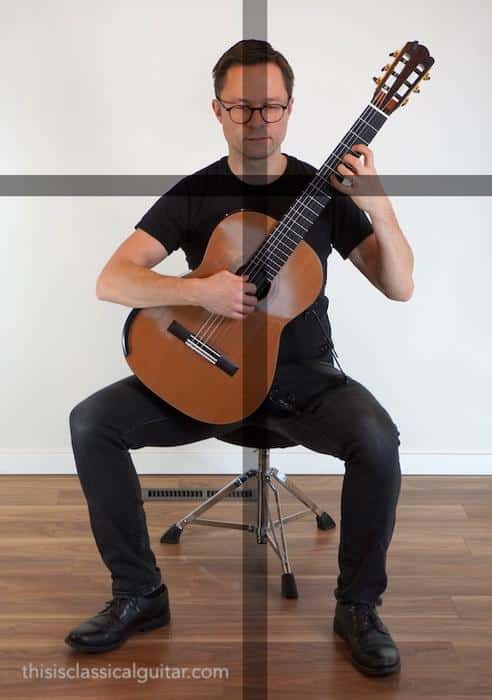I still remember that defining moment as a six-year-old, the heavy feeling of my first guitar in hands, confronted by the daunting class of stance and precision called the classical guitar position. It was not just another way of playing the guitar; it was a discipline, an art that required a specific blend of posture and elegance. I’ve devoted years to mastering the classical guitar posture, and now, I’m here to guide you through your journey.
From some startling research, it was found that approximately 70% beginner guitarists weren’t formally taught the classical guitar sitting position. Can you believe that? The vital essence of sound authenticity and true command of the classical guitar often misunderstood or entirely overlooked! Alleviating this dilemma is exactly my purpose here. Those intricate nuances of the classical guitar posture, once understood and adopted, could elevate your performances, regardless of your skill level.
Nestled in this comprehensive guide is the bold, perhaps surprising claim that the foundation of successful, soulful guitar performances is in perfecting classical guitar position. Rather than jumping right into those burning chords and breathtaking riffs, mastering the classical guitar posture could transform every note that flows from your strings. But how so? Stick around! Let’s dive into the delicacies of ideal guitar sitting positions, the use of a footstool, even perhaps sprinkling a dash of ergonomics in the mix and optimizing your overall control over your instrument.
The classical guitar posture and sitting position is an art, one that I have indulged in since my tender age of six. The pursuit of this knowledge has brought me immense growth and proficiency. I confidently say that this journey is one that’s worth every aspiring guitarist’s time and devotion. Let’s unearth those details together, shall we?
Why Correct Classical Guitar Position Matters
The Importance of Proper Guitar Technique

Throughout my musical journey, mastering proper guitar technique has opened the door to gracefully melding several music genres. The significance of this technique cannot be overstated – it is the backbone that often dictates the quality of the sound produced. Just like a painter meticulously selects the right brushes to bring their vision to life, the proper guitar technique is an essential tool in unlocking your potential as a guitarist.
Without proper guitar technique, my experience has taught me that even naturally talented musicians may find it challenging to reach their full potential. However, learning to hold, strum, fret, and pluck properly can enhance your tone, increase speed, improve overall performance, and prevent injuries. The difference it makes is significant; it is the detail that sets apart amateurs from virtuosos.
To truly master the classical guitar, one must understand the importance of correct positioning. Yet, a correct position without proper technique is like having a map but no compass. The two concepts work hand in hand: one sets the foundation, while the other refines it.
Embracing this fact on my journey has boosted my progression remarkably. Infusing the art of execution with the theory of positioning has revealed the distinct hues in every note, enhancing my exploration of various music genres.
In essence, proper guitar technique is a crucial ladder to musical excellence. Mastering it can take your guitar playing experience from simply satisfactory to breathtakingly exceptional. Stay tuned as we delve deeper into how to prevent injuries while playing the guitar, another crucial aspect of your journey towards mastering the classical guitar position. Keep in mind that taking care of your overall health is equally important as practicing your chords.
Prevention of Injuries While Playing Guitar

Having traversed the often complex journey of understanding the correct classical guitar position, I have uncovered the grave importance of preventing injuries while playing guitar. Not only does an inappropriate posture diminish your performance, but it may also significantly harm your physical health. Let me share some key insights and tips to keep your music-making journey safe and enjoyable.
Foremost, establishing the correct guitar position is paramount in preventing injuries. Yes, it contributes to improved sound and technique but, crucially, it aids in reducing strain on your back, neck, and shoulders. Consistent strain, I have observed, leads to long-term injuries that can bring your guitar playing career to a premature halt. It’s not worth the risk.
Secondly, remember, the guitar should adjust to you, not the other way round. A stiff, forced adjustment to the guitar can cause unnecessary physical stress. Listen to your body. If your muscles or joints ache or begin to feel numb, it’s a signal that you need to adjust your position or take a break.
Regular exercising and stretching cannot be overlooked. Strengthening and maintaining flexibility in your hands, wrists, and fingers are essential to prevent injuries. I consider my exercise routine as crucial to my practice as my scales.
Lastly, warming up before delving into serious playing is a preventative measure I cannot stress enough. Just as athletes warm-up before a match, warming up your hands and fingers not only boost your performance but also function as an injury deterrent.
By integrating these preventive measures into your playing routine, not only will you enhance your musical prowess, but also ensure your journey with the classical guitar remains unbridled by avoidable injuries. In the following sections, we shall delve deeper into how to establish correct sitting positions, utilize tools like footstools, and incorporate ergonomics. Trust me, every little adjustment and effort counts towards mastering the art of the classical guitar.
Establishing a Correct Classical Guitar Sitting Position
Utilising a Footstool

After discussing the basics of a correct classical guitar sitting position, let’s now shed light on a simple but crucial piece of equipment – the footstool. It’s an oft-overlooked accessory that plays a significant role in establishing the proper posture. My journey through various playing attitudes led me to appreciate the humbleness and the utility of guitar footstool. Allow me to share how this can be effectively utilized to elevate your musical performance.
The classical guitar footstool functions as a height-adjustable support for your left foot (for right-handed players). Elevating the left foot aligns your spine and balances the weight of the guitar on your body, helping establish a proper guitar footstool posture.
Rest your foot on the footstool while sitting on the edge of your chair. The raised foot forms a 90-degree angle at the knee with the guitar resting on your left thigh. This allows your left hand easy and unstrained access to the fretboard. If adjusted correctly, the footstool relieves back and neck stress, allowing you to focus entirely on producing quality sound.
Mind, though, that adjustment matters. Too high and it can strain your back, too low and it might cause discomfort and difficulties in reaching for the fretboard. Experiment and find a height that allows you to hold the guitar securely at a 45-degree angle against your chest, while keeping your neck and back straight.
In conclusion, the use of a footstool is an excellent aid in maintaining the proper classical guitar sitting position. It primarily increases comfort and reduces strain, positively affecting your long-term technical progress and overall performance quality. Remember, finding your perfect footstool height will involve trial and adjustments. Don’t be afraid to modify and evolve your sitting position, ensuring it continues to match your ongoing development as a classical guitarist.
In our following section, we shall explore the contribution of Incorporating Ergonomics towards perfecting the art of positioning the Classical Guitar, taking our discussion a notch higher and broadening our perspective. Stay tuned.
Incorporating Ergonomics

In my journey towards mastering the classical guitar, one concept that has greatly revolutionized my practice and performance is the implementation of ergonomic principles in guitar playing. This not only significantly enhances playing comfort but also increases sustainability for long hours of practice sessions.
Ergonomic guitar playing involves making adjustments in aspects such as your sitting position, the way you hold the guitar, the angle at which you position your wrist, among others. These slight modifications can result in a profound impact on your overall comfort and endurance in performance. Furthermore, they contribute to reducing the risk of straining or injuring your muscles due to inappropriate posture or repetitive motions.
Enabling both a proficient performance and protecting myself from unnecessary pains, I can truly attest to the value of integrating ergonomics into the classical guitar sitting position. Here’s how you can do it too:
Start by adjusting the height and angle of your guitar, allowing the instrument to rest comfortably against your body. This means avoiding any unwanted stress or tension in your arms, shoulders, or back. Keep a relaxed arm position, with your arms not excessively outstretched or cramped.
Next, pay attention to the position of your wrist while playing. It should be relaxed and neutral, not bent or twisted. This prevents undue stress on your tendons and maintains the ease in movement.
Lastly, do not neglect the importance of regular short breaks. Intense practice sessions can be tiring, and without an adequate rest, your muscles can become strained or fatigued. A couple of minutes of rest in between can be very beneficial for your overall productivity and progress.
Incorporating ergonomics need not be a complex process. It’s all about understanding your body and making slight changes that resonate with comfort and ease. Remember, the aim is to seamlessly harmonize yourself with your instrument, enabling a performance that is not just technically proficient, but also physically sustainable.
Getting the right sitting position, utilizing ergonomic principles and a footstool to maximize comfort and minimize strain puts you on the path to attaining an optimized sound output, which we’ll delve into in the next segment. So, stick around as we talk about optimizing guitar position for sound.
Optimizing Guitar Position for Sound
Guitar Sound Optimization Techniques

Having stressed on the significance of optimizing guitar position for sound in the preceding sections, let’s delve deeper into specific techniques to bring the best out of your instrument. As a fingerstyle guitarist, I can provide personalized advice drawn from my experiences on mastering the guitar sound.
The primary element to consider when enhancing your guitar sound is where and how you strike the strings. Strumming closer to the bridge delivers a brighter, more trebly sound, while plucking nearer to the fretboard results in a warmer resonating tone. It’s worthwhile to experiment across the soundboard when honing in on your preferred timbre.
Technique, too, plays a crucial role in optimizing guitar position for sound. Practicing rest strokes and free strokes on the strings subtly alters the timbre. While rest strokes usually create a fuller sound, free strokes deliver a mellower tone. The choice between these lies in your sonic preference and the mood of the piece you are playing.
The angle at which you attack the strings is as important as your strumming location and technique, a point emphasized under the aspect of ‘optimizing guitar position for sound’. The more perpendicular your approach, the fuller the audio output. However, slight tilts can produce distinct tonal nuances.
Further, keeping your guitar in top-notch condition is essential. A well-maintained guitar not only simplifies the process of achieving a desired sound but also ensures smooth control over the instrument. Regularly clean and occasionally change your strings, always ensuring the tuning pegs and fretboard are dust-free.
Remember, mastering your instrument’s sound dynamics contributes significantly to expressing your musicality and personality through your performances. Thus, understanding and implementing these guitar sound optimization techniques can dramatically increase the richness of your guitar’s sound.
As we conclude this section, set aside some time to apply these techniques. The subsequent sections will explore adjusting classical guitar posture and answer frequently asked questions, which, combined with these sound optimization techniques, ensures the classical guitar experience is rewarding and fulfilling.
Tips for Improving Classical Guitar Posture

Transitioning from our earlier discussion on optimizing your guitar position for sound, let’s delve into some practical steps for improving guitar posture – a fundamental component for achieving optimal sound quality. My years of practicing and performing classical guitar have given me a wealth of experience in this regard, and I’d like to share some refined tips with you.
Your classical guitar playing posture becomes the foundation for your sound production; thus, it’s vital to get it right. Improving guitar posture is a continuous process that requires consistent focus and dedication. Here are some practical classical guitar practice tips to help you along your journey.
Firstly, do regular checks on your posture during practice sessions. Unconsciously, we often slip into bad posture habits as we focus more on playing. These checks help you correct such tendencies and maintain the right posture.
Furthermore, ensure your guitar neck is angled upward. This posture naturally positions your hand closer to the fretboard, allows your fingers easier access to the strings, and contributes to producing a quality sound.
Next, keep your back straight and avoid leaning into the guitar. Players often lean into the guitar to get a better view of the fretboard. However, this can lead to posture issues and does not necessarily improve your performance.
Last but not least, use a footstool or guitar support to elevate the guitar. Elevation brings the instrument to a comfortable playing position more aligned with your body mid-line, subsequently reducing strain and increasing comfort in the long run.
Building good posture habits during guitar practice sessions is instrumental in your journey to mastering the classical guitar position. It positively impacts your sound quality and overall comfort. These classical guitar practice tips should serve as a guiding light as you progress in your classical guitar practice.
As we shift gears to our next topic, ‘Guitar Sound Optimization Techniques,’ bear in mind that a sound posture lays the groundwork for achieving a rich, resonant sound, thereby further bringing us closer to the ultimately optimized guitar playing experience.
FAQs
What is the proper classical guitar position?
How can I make the classical guitar position more comfortable?
What are some common mistakes when assuming the classical guitar position?
Why is mastering the classical guitar position important?
Conclusion
Mastering the classical guitar posture has been, for me, a relentless journey of embodiment and mindfulness, cast from decades of experience. It’s the harmonious union of being ergonomic-friendly, technique-driven, and passionately immersed that brings the best music into existence. This understanding and practice have played a huge role in my musical journey and progress.
These tenets of ergonomic guitar playing not only optimizes sound but prevents potential physical injuries, such as strains, that come from awkward body movements and strumming postures. They have served as my guide, time and time again, to a healthier, melodically-rich guitar-playing experience.
From sitting correctly on the chair, to using a footstool and adjusting the neck and head positions- every detail matters. It is incumbent upon every classical guitar player to incorporate ergonomics into their practice from the get-go. Indeed, playing the guitar is as much a physically engaging process as it is a musical one.
Over the years, I’ve come to embrace the fact that good technique permeates every musical note and every string vibration. Technique and posture are our blueprint, our language to communicating a vibrant classical guitar performance.
In conclusion, understanding and mastering the classical guitar position is an ongoing process. Practice slowly, mindfully, and with a dash of patience. Feel the music, let it guide your hands and body, and the results will truly amaze you. Classical guitar playing is not merely a technical activity, but a holistic language of passion, technique, and supreme ergonomics at play.
